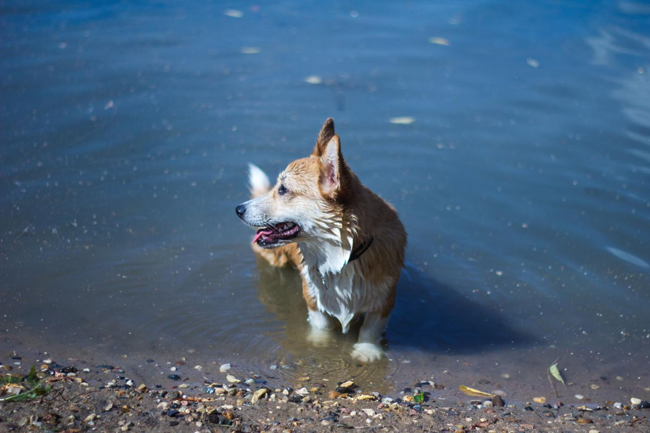
Some algae can hurt humans and animals. Credit: Anton Scherbakov on Unsplash
— Published by Lancaster Online (Filed by Erin Negley, Staff Writer)
This blue-green algae found in Pennsylvania can hurt dogs
Lancaster, PA, October 19, 2020 - Last year, when three dogs died from toxic algae poisoning, the news spread quickly. Pet owners were worried about their animals’ safety.
To make the issue more complicated, the type of algae that can harm animals is not easy to spot. It might be called blue-green algae, but it actually can look like clear water or a range of colors.
Penn State Ag Extension hosted a webinar about harmful algae blooms and protecting animals. It was led by Brian Swistock, extension water resources specialist and Peter Wulfhorst, extension water resources educator.
Here are a few highlights. The full one-hour webinar can be found here.
Is all algae dangerous?
No. Most algae are completely harmless, Swistock says.
The most common algae is filamentous algae, which has filaments that float to the top of water surface. This type of algae can be picked up and is mostly harmless.
Planktonic algae are microscopic and make water look cloudy. Some types are harmless.
One type of planktonic algae is blue green algae, which is harmful to humans and animals.
How can I identify blue-green algae?
“If you’re able to pick up the algae, chances are, it’s harmless,” Swistock says.
If it dissipates when you try to pick it up, that’s an indicator that it might be harmful.
One way to identify blue-green algae is to look at it under a microscope.
Outside of a lab, there are ways to identify blue-green algae, Wulforst says.
The algae can look green, blue-green, black, white, purple, brown or red. A clear pond or lake may have had a recent harmful algae bloom and could still have toxins present.
The algae can also look like surface film, crust, dots, grass clippings, spilled paint or pea soup.
Where are blue-green algae found in Pennsylvania?
This harmful algae have been found in Lake Erie and in ponds and lakes throughout the state for decades.
They are most commonly found:
In old ponds and lakes, which have more nutrients to feed algae,
In shallow water,
In ponds and lakes with Ponds and lakes with surface runoff,
From mid-July to October
Shortly after a large rainstorm, which adds nutrients to the pond or lake.
How can pond and lake owners prevent algae blooms?
Plant buffer strip on the edge of a pond or lake to capture nutrients before they enter the water.
Create a sediment pond for water before it enters a pond or lake.
Manage and maintain septic systems in the area.
Aerate to control phosphorus levels.
Reduce fertilizer use around the pond.
Stabilize banks to keep soil out of the water.
Control animals, like geese, and their waste.
If you see a bloom starting, treat it with an algaecide.
How can you protect animals?
“If it’s not a water body that you see regularly, the only true protection from these toxins is to keep animals out, regardless of the appearance,” Wulfhorst says.
Only allow dogs to play in ponds or lakes you visit regularly and see if conditions change.
Ask for those managing a pond or lake for test results.
The CyAN app from EPA and NOAA has history of blooms of lakes. Currently, it’s only available for Android devices but a web version is in the works.
Take your own tests. Some range from $25-$40 per sample and give results in 30-60 minutes.
Send photos of suspicious water to experts.
Where can I learn more?
Pennsylvania Sea Grant has resources online, including lots of photos.
New York Sea Grant has a guide specific to dogs and harmful algae blooms.
The National Centers for Coastal Ocean Science has a guide related to dogs.
Penn State Extension has lots of resources on pond management.
More Info: New York Sea Grant
New York Sea Grant (NYSG), a cooperative program of Cornell University
and the State University of New York (SUNY), is one of 34 university-based
programs under the National Oceanic and Atmospheric Administration’s
National Sea Grant College Program.
Since 1971, NYSG has represented a statewide network of integrated
research, education and extension services promoting coastal community
economic vitality, environmental sustainability and citizen awareness
and understanding about the State’s marine and Great Lakes resources.
Through NYSG’s efforts, the combined talents of university scientists
and extension specialists help develop and transfer science-based
information to many coastal user groups—businesses and industries,
federal, state and local government decision-makers and agency managers,
educators, the media and the interested public.
The program maintains Great Lakes offices at Cornell University, University at Buffalo, SUNY Oswego and the Wayne County Cooperative Extension office
in Newark. In the State's marine waters, NYSG has offices at Stony Brook
University in Long Island, Brooklyn College and Cornell Cooperative
Extension in NYC and Kingston in the Hudson Valley.
For updates on Sea Grant activities: www.nyseagrant.org has RSS, Facebook, Twitter, Instagram and YouTube links. NYSG offers a free e-list sign up via www.nyseagrant.org/nycoastlines for its flagship publication, NY Coastlines/Currents, which is published quarterly. Our program also produces an occasional e-newsletter,"NOAA Sea Grant's Social Media Review," via its blog, www.nyseagrant.org/blog.